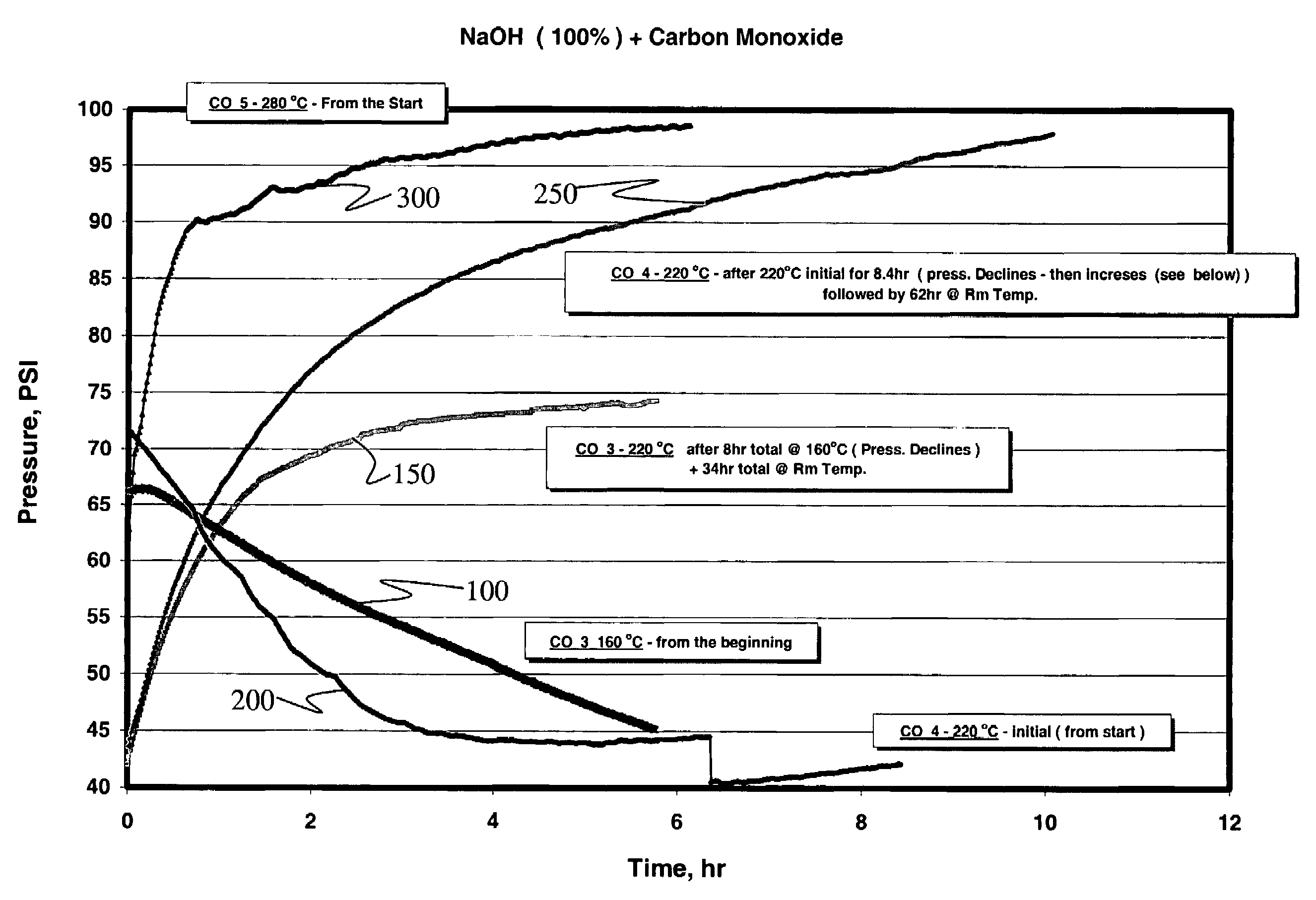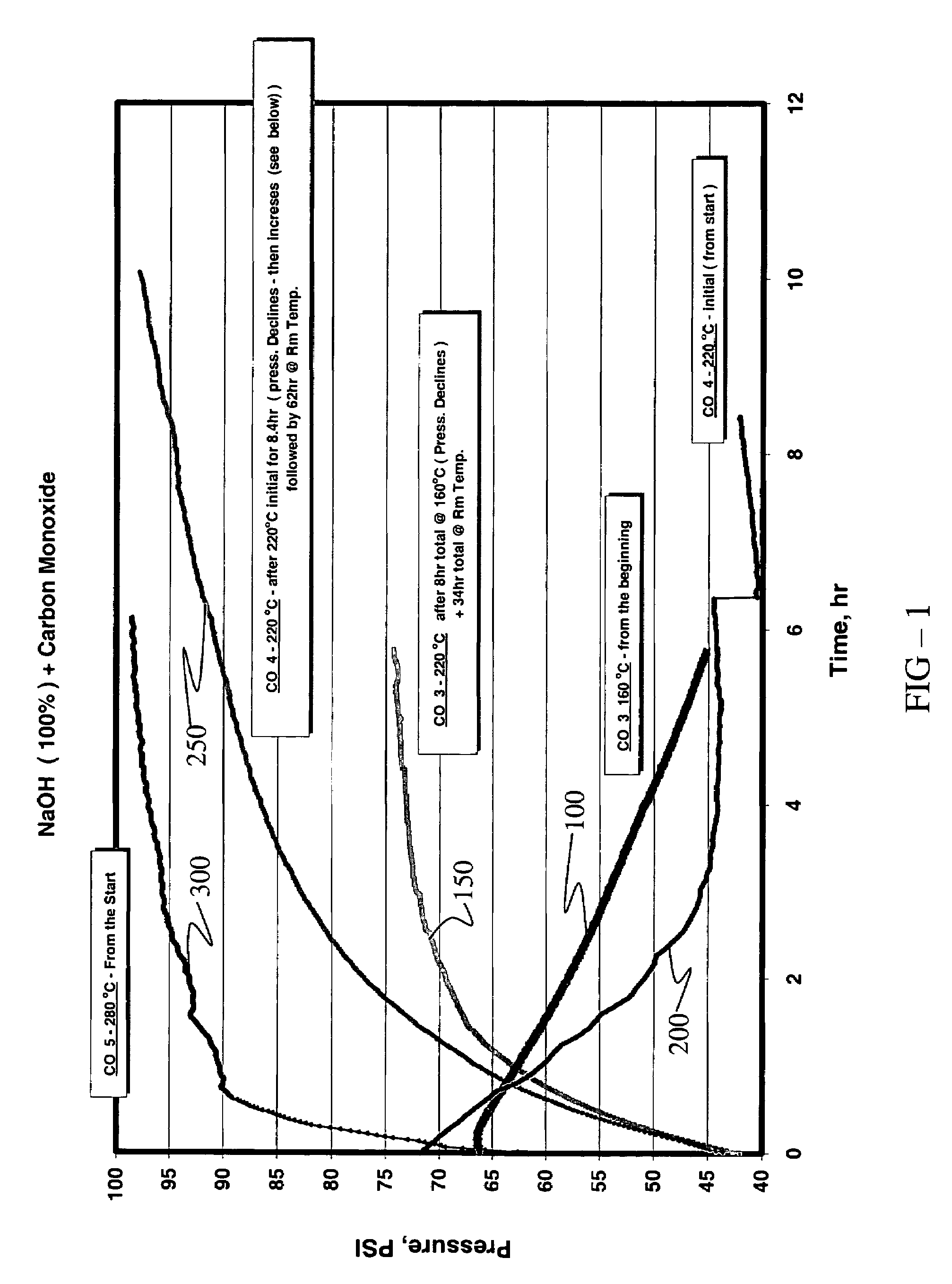Production of hydrogen via a base-facilitated reaction of carbon monoxide
a carbon monoxide and hydrogen gas technology, applied in the direction of combustible gas production, molten salt/metal gasification, products, etc., can solve the problems of escalating costs, destabilizing economies as well as the likelihood, and increasing fossil fuel consumption, so as to improve the thermodynamic spontaneity of production, increase the equilibrium conversion rate, and accelerate the
- Summary
- Abstract
- Description
- Claims
- Application Information
AI Technical Summary
Benefits of technology
Problems solved by technology
Method used
Image
Examples
example 1
[0034]In this example, the production of hydrogen from a reaction of carbon monoxide and a base is demonstrated. More specifically, hydrogen was produced from a reaction of carbon monoxide (CO) and sodium hydroxide (NaOH). Solid phase NaOH (which is hygroscopic and included ˜10% adsorbed water) was used in this experiment.
[0035]About 7 g of the NaOH was placed into a stainless steel reaction vessel having a total volume of ˜40 mL. The reaction vessel was evacuated, flushed multiple times with CO to eliminate air from the reaction environment, and filled with CO to a pressure of 60 psi. The vessel was then sealed. The temperature of the vessel was raised to 160° C. and held at that temperature for 8 hours. The vessel was then cooled to room temperature, allowed to stand for 34 hours, subsequently heated to 220° C. for 8 hours and cooled once again to room temperature to conclude the experiment.
[0036]Samples of the gas phase were periodically extracted from the reaction vessel at vari...
example 2
[0040]In this example, the production of hydrogen from a reaction of carbon monoxide and a base is further demonstrated. More specifically, hydrogen was produced from a reaction of carbon monoxide (CO) and sodium hydroxide (NaOH). The reaction vessel, solid phase NaOH and CO are as described in EXAMPLE 1 hereinabove.
[0041]About 7 g of the NaOH was placed into a stainless steel reaction vessel having a total volume of ˜40 mL. The reaction vessel was evacuated, flushed multiple times with CO to eliminate air from the reaction environment, and filled with CO to a pressure of 65 psi. The vessel was then sealed. The temperature of the vessel was raised to 220° C. and held at that temperature for over 8 hours. The vessel was then cooled to room temperature, allowed to stand for 62 hours, subsequently heated back to 220° C. for 10 hours and cooled once again to room temperature to conclude the experiment. Samples of the gas phase were periodically extracted from the reaction vessel at vari...
example 3
[0045]In this example, the production of hydrogen from a reaction of carbon monoxide and a base is further demonstrated. More specifically, hydrogen was produced from a reaction of carbon monoxide (CO) and sodium hydroxide (NaOH). The reaction vessel, solid phase NaOH and CO are as described in EXAMPLE 1 hereinabove.
[0046]About 7 g of the NaOH was placed into a stainless steel reaction vessel having a total volume of ˜40 mL. The reaction vessel was evacuated, flushed multiple times with CO to eliminate air from the reaction environment, and filled with CO to a pressure of 60 psi. The vessel was then sealed. The temperature of the vessel was raised to 280° C. and held at that temperature for over 6 hours. The vessel was then cooled to room temperature to conclude the experiment.
[0047]Samples of the gas phase were periodically extracted from the reaction vessel at various stages during the reaction and were analyzed using gas chromatography to determine the relative presence of O2, N2...
PUM
| Property | Measurement | Unit |
|---|---|---|
| temperatures | aaaaa | aaaaa |
| temperatures | aaaaa | aaaaa |
| temperatures | aaaaa | aaaaa |
Abstract
Description
Claims
Application Information
 Login to View More
Login to View More - R&D
- Intellectual Property
- Life Sciences
- Materials
- Tech Scout
- Unparalleled Data Quality
- Higher Quality Content
- 60% Fewer Hallucinations
Browse by: Latest US Patents, China's latest patents, Technical Efficacy Thesaurus, Application Domain, Technology Topic, Popular Technical Reports.
© 2025 PatSnap. All rights reserved.Legal|Privacy policy|Modern Slavery Act Transparency Statement|Sitemap|About US| Contact US: help@patsnap.com



